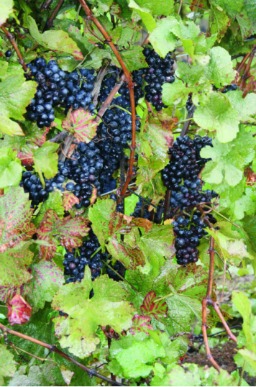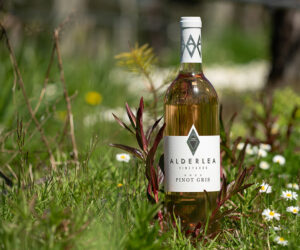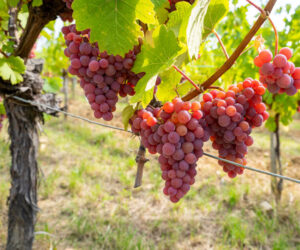
While traveling recently in the Burgundy region of France, it was easy to see why the world loves Pinot Noir. It is the only red grape grown in that region, and the grape provides a great example for understanding what the French mean by the term terroir. I’ve written often about terroir and I feel that New World winemakers abuse the term, which is admittedly inherently general in nature. But I have a lot of respect for Old World wine growers and winemakers who use the term. Terroir is about the people, the climate, the land and the grape that is grown there. The terroir of Burgundy is about the same grape grown on varied soils and exposures, traditional farming methods, and family secrets of winemaking. I found in Burgundy a wide range of wines, which each seemed to have something “signature” about it. Call it terroir, or just call it diverse. If it was a red wine, it was Pinot Noir.
Pinot has a long history in Burgundy, going back to before the Roman times. As the name implies, Pinot Noir is a black grape, which some winemakers refer to as the “devil.” This could be because it has a reputation for being a challenge in the vineyard and winery, especially when trying to translate the colors of the grape into the wine.
Long ago, the French system of Appellation d’origine contrôlée (AOC) was established, and historically generations of winemakers knew where the best wines were produced. These were the ones located mid-way on the slopes on the Côte de Nuits region of Burgundy; a region that runs north to south from the city of Dijon to Beaune. The Côte de Nuits region encompasses from the bottom of the hill to almost the top, but it is the Grand Cru that is perfectly situated at the precise location on the hillside to maximize sunlight exposure.
French lore says that the hillside locations present the precise angle of the sun to maximize the potential color in the grape. Such famous Grand Cru vineyard names of Chambertin, Clos de Vougeot, and Romanée-Conti, produce some of the most expensive wine in the world. There are 27 Grand Cru vineyards producing Pinot Noir in Burgundy, totaling just less than 1.5 percent of the total Pinot Noir production in Burgundy. The remaining AOCs in Burgundy are Village or Premier Cru wines that also hold their own on the world market, and they are generally more affordable to the average wine consumer.
Pinot Noir can wear many hats if it is grown in the right climate. It is best when grown in cooler regions, such as Burgundy. The challenges to the growers are that cooler climates also experience more summer rain. In Burgundy this last summer, rain and thunderstorms with hail challenged many vineyards, and crop losses were significant in some areas. During our visit, some growers told us they had lost more than half of their crop due to an overnight hailstorm. While a spray program can mitigate fungal pressure, not much can be done to keep the hail from damaging the vines. This is a good example of how growing conditions from vintage to vintage can be varied, and often the better wines are blends from different vineyards and AOCs.
Growing Pinot Noir in cool climates contributes to crisp acidity. While it is generally dry throughout the growing season in California, the long growing season yields wines that are lower in acidity, and the best Pinots are limited to the cool Anderson Valley in Mendocino County, the Carneros region of Sonoma County, Napa and Santa Barbara County, and there are also some good examples hailing from the Petaluma Gap district. Interestingly, this production accounts for less than one third of the statewide tonnage of Pinot Noir. The remaining tonnage is planted in the hotter San Joaquin Valley where the production goes to bulk wines. Examples of planting in warm regions of California yield wines that are bitter and lack color and are of generally poor quality.
Elsewhere on the US West Coast, some other very fine examples come from Oregon, where the cooler climate, similar to that of Burgundy, produces wines with crisp acidity and color. In 2010 the Oregon grape report listed 12,406 acres of Pinot Noir, most of which is planted in the Willamette Valley region, just south of Portland. While only some of the vineyards are on hillsides, mimicking that of Burgundy, trellising systems that open up the canopy and present the fruit to the sun are common. The open canopy also allows for good penetration of fungicides, which is good as Oregon can experience some wet summers. Low yields of two to three tons per acre allow the vine to concentrate its efforts on maturation and ripening.
There are some grapes that, no matter what a winemaker does in the winemaking process, translate itself into the wine. Pinot Noir is one of those grapes. Some refer to the grape as delicate. Winemakers for centuries have been challenged in how to translate color to the wine, which is more difficult to do with Pinot Noir than, say, Syrah or Cabernet. This is because Pinot Noir has much less color (anthocyanins) and therefore the grapes must be processed differently than a Syrah to extract as much color as possible. Regimens of cold soaking prior to fermentation, elevated temperature during fermentation, seed removal and harvesting on lunar cycles are used but there is no sound research on the best means to translate the color from the grape to the wine other than sound viticultural practices that produce the maximum amount of color possible in the grape.
Fermentations in open top fermenters with a myriad of methods to punch down the cap are the norm in many wineries that produce Pinot Noir. I have seen cellar workers walking the 2×12 plank above the fermentation tank with a punch down tool as well as seen sophisticated, computer-controlled hydraulic punch down devices perform punch downs at specified intervals based on either time intervals or the temperature of the cap. Most winemakers making wine agree that “soft” processing techniques are best with this grape. By soft, I mean limiting the use of pumps.
Pinot Noir winemakers tend to use gravity whenever possible and remove the wine from barrels by displacing the volume with inert gas. For example, a winery I visited in Burgundy was actually three stories tall – underground. The winery received fruit at ground level where it was destemmed and crushed then transferred to the level just below. When fermentation was complete, the wine was transferred to the 10,000 barrel capacity cellar below that. The wine was then aged, racked and bottled on the same level. It did not see daylight after crushing until it left the winery in a bottle. This winery happens to also be where I tasted some of the best examples of Burgundy Pinot Noir.
Before I went to Burgundy, I was influenced by the California image of Pinot Noir. The styles of wines between the two regions are markedly different, and that was evident after my visit. To claim that one style is better than the other is just not fair. There are good producers in both regions. But what I can say after that trip is that Burgundian red wine production has been honed to perfection for hundreds of years, and the style has taken on its signature following. The French winemakers understand their terroir. I think it will still be many years before the same can be said about the Pinot Noir in the New World. There are many fine examples of Pinot Noir in each of these regions, and I think that only time will tell.
Ingredients
• 125 pounds (57 kg) fresh Pinot Noir fruit or 5-gallons (19-L) fresh juice
• Distilled water
• 10 % potassium metabisulfite (KMBS) solution: Weigh 10 grams of KMBS, dissolve into about 50 milliliters (mL) of distilled water. When completely dissolved, make up to 100 mL total with distilled water.
• 5 grams Lallemand BGY (UCD-51) or Premier Cuvée yeast.
• 10 grams Di-ammonium Phosphate (DAP)
• 10 grams Go-Ferm
• 10 grams Fermaid K (or equivalent yeast nutrient)
• Malolactic fermentation starter culture (CHR Hansen or equivalent)
Other needs
• (1) 15-gallon (57-L) food-grade plastic bucket for fermentation
• (2) 5-gallon (19-L) carboys
• (1-2) 1-gallon (3.8-L) jugs
• Racking hoses
• Destemmer/Crusher
• Winepress
• Inert gas – nitrogen, argon or carbon dioxide
• Ability to maintain a fermentation temperature of 85–90 °F (30–32 °C).
• Thermometer capable of measuring between 40–110 °F (4–43 °C) in one degree increments.
• Pipettes with the ability to add in increments of 1 milliliter
• Clinitest® tablets
• Tartaric acid
Step by step
1. Clean and sanitize all your winemaking tools, supplies and equipment.
2. Crush and destem the grapes.
3. Transfer the must or juice to your fermenter. During the transfer, add 15 milliliters of 10% KMBS solution (This addition is the equivalent of 50 ppm SO2). Mix well.
4. Take a sample to test for Brix, acidity and pH. Keep the results handy.
5. Layer the headspace with inert gas and keep covered. Keep in a cool place overnight.
6. The next day suspend the Fermaid K in a little distilled water (usually ~ 20 mL). Add to must or juice and mix well.
7. Go back to your lab results. Typical Brix for this style is 24–25 °B. Typical acid levels will be 0.65-0.70%. Adjust as necessary using tartaric acid. If the acid is higher than 0.70%, don’t panic, this recipe calls for a minimum final acidity of 0.50%.
8. Prepare yeast: Heat about 50 mL distilled water to 108 °F (42 °C). Mix the Go-ferm into the water to make a suspension. Take the temperature. Pitch the yeast when the suspension is 104 °F (40 °C). Sprinkle the yeast on the surface and gently mix so that no clumps exist. Let sit for 15 minutes undisturbed. Measure the temperature of the yeast suspension. Measure the temperature of the must. Note: Do not add the yeast to your cool juice if the temperature of the yeast and the must temperature difference exceeds 15 °F (8 °C). Acclimate your yeast by taking about 10 mL of the must juice and adding it to the yeast suspension. Wait 15 minutes and measure the temperature again. Do this until you are within the specified temperature range. Do not let the yeast sit in the original water suspension for longer than 20 minutes.
9. Add the yeast to the fermenter and mix. You should see signs of fermentation within about one to two days.
10. Push the grapes back into the juice to promote color, and tannin extraction each day. This is called “punching down.”
11. Monitor the Brix and temperature twice daily during peak fermentation (10–21 °Brix). Morning and evening is best and more often if the temperature shows any indication of exceeding 85 °F (29 °C). Keep the temperature between 85–90 F. Do not cool off to less than 80 °F (27 °C).
12. At about 19 °Brix, dissolve the DAP in a small amount of distilled water and mix into the must.
13. When the Brix reaches 0 (about 5–7 days), transfer the must to your press and press the cake dry. Keep the free run wine separate from the press portion for now. Label your vessels.
14. Transfer the wine to carboys or 1-gallon (3.8-L) jugs. Your press fraction may only be a gallon or two. Leave no headspace.
15. Place an airlock on the vessel(s) and label the vessels.
16. Inoculate with your malolactic (ML) bacteria. Check the manufacturer’s instructions on how to prepare and inoculate. Cover the tops with a breather to allow CO2 to escape.
17. Monitor the ML fermentation using a thin layer chromatography assay according to the kit instructions.
18. When the ML is complete, measure the residual sugar using the Clinitest®. You are looking for the results to be 0.5% or lower.
19. Add 2 mL of fresh KMBS (10%) solution per gallon of wine. This is the equivalent to ~40 ppm addition.
20. Let wine settle in a cool place.
21. Add oak chips to your press fractions if you wish. Do not treat the entire lot of wine.
22. After two weeks, test for pH and SO2, adjust the SO2 as necessary to attain 0.8 ppm molecular SO2. Check the SO2 in another two week and adjust. Maintain this level. You’ll just need to check every two months or so, and before racking.
23. Rack the wine clean twice over 6–8 months time frame to clarify. Fining and /or filtration as needed.
24. Once the wine is cleared, it is time to move it to the bottle. This would be about twelve months after the completion of fermentation.
25. Blend to integrate the oak fraction back into the free run. You may not need it all.
26. If all has gone well you can filter if desired and bottle. Always be sure to maintain sanitary conditions in your winery while bottling. Once bottled, you’ll need to periodically check your work by opening a bottle to enjoy with friends.







